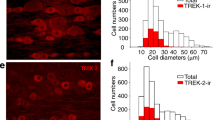Abstract
The Br neuron of the snail Helix pomatia, involved in neuronal regulation of various homeostatic and adaptive mechanisms, represents an interesting model for studying effects of temperature changes on neuronal activity of poikilotherms. The acetylcholine (ACh) induces a transient, inward dose-dependent current in the identified Br neuron. In the work presented, we analyses the effects of cooling on the ACh-induced inward current. The amplitude of ACh-induced inward current was markedly decreased after cooling and the speed of the decay of ACh response was decreased. Sensitivity to cooling of Ach-activated current on the Br neuron is mediated by a mechanism that does not involve change in the apparent receptor affinity or the cooperativity of binding.




Similar content being viewed by others
References
Airapetyan SN (1969) Effect of temperature on the membrane potential of the giant neurons of the snail. Biofizika 14(4):663–668
Alevizos A, Weiss KR, Koester J (1991) Synaptic actions of identified peptidergic neuron R15 in Aplysia. III. Activation of the large hermaphroditic duct. J Neurosci 11:1282–1290
Bablanian GM, Treistman SN (1985) The effect of hyperpolarization of cell R15 on the hemolymph composition in intact Aplysia. J Comp Physiol B 155:297–303
Carpenter DO (1967) Temperature effects on pacemaker generation, membrane potential and critical firing threshold in Aplysia neurons. J Gen Physiol 50(6):1469–1484
Evans ML, Carpenter DO (1989) Desensitization kinetics of a chloride acetylcholine response in Aplysia. Brain Res 495(2):309–318
Ffrench-Mullen JMH, Tokutomi N, Akaike N (1988) The effect of temperature on the GABA-induced chloride current in isolated sensory neurons of the frog. Br J Pharmacol 95:753–762
Fletcher DS, Ram LJ (1990) High temperature induces reversible silence in Aplysia R15 bursting pacemaker neuron. Comp Biochem Physiol 98A (3–4):399–405
Frazier W, Kandel E, Kupffermann I, Waziri R, Coggeshall R (1967) Morphological and functional properties of identified neurons in the abdominal ganglion of Aplysia californica. J Neurophysiol 30:1288–1351
Ger BA, Katchman AN, Zeimal E (1979) The slow potassium-dependent acetylcholine current in isolated molluscan neurone: its time course and temperature dependence. Brain Res 171:355–359
Jahan-Parwar B, Smith M, Baumgarten RV (1969) Activation of neurosecretory cells in Aplysia by osphradial stimulation. J Physiol (London) 216:1246–1257
Johnston D (1980) Voltage, temperature, and ionic dependence of the slow outward current in Aplysia burst-firing neurons. J Physiol (London) 298:145–157
Katchman AN, Ger BA, Zeimal EV (1980) The slow phase of the acetylcholine response in isolated neurons of the gastropod mollusk, Planorbarius corneus. Gen Pharmacol 11:55–64
Kehoe J (1972) Three acetylcholine receptors in Aplysia neurones. J Physiol 225:115–146
Kerkut GA, Meech PW (1967) The effect of ions on the membrane potential of snail neurons. Comparative Biochemistry and Physiology 20:411–429
Kerkut GA, Ridge AP (1962) The effect of temperature changes on the activity of the neurones of the snail Helix aspersa. Comp Biochem Physiol 5:283–295
Kerkut GA, Lambert JDC, Gayton RJ, Loker EJ, Walker RJ (1975) Mapping of nerve cells in the subesophageal ganglia of Helix aspersa. Comp Biochem Physiol 50A:1–25
Koestler J, Mayeri E, Liebeswar G, Kandel ER (1974) Neural control of circulation in Aplysia. J Neurophysiol 37:476–496
Kordas M, Zorec R (1984) The voltage and temperature dependence of the end-plate current in frog skeletal muscle. Pflügers Arch 401:408–413
Lagerspetz KYH (1974) Temperature acclimation and the nervous system. Biol Rev 49:573–598
Marchiafava PL (1970) The effect of temperature change on membrane potential and conductance in Aplysia giant nerve cell. Comp Biochem Physiol 34:847–852
Moffett S, Wachtel H (1976) Correlations between temperature effects on behavior in Aplysia and firing patterns of identified neurons. Mar Behav Physiol 4:61–74
Peper K, Bradley RJ, Dreyer F (1982) The acetylcholine receptor at the neuromuscular junction. Physiol Rev 62:1271–1340
Rittenhouse AR, Price CH (1985) Peripheral axons of the parabolic burster neuron R15. Brain Res 333:330–335
Salanki J, Evans ML, Carpenter DO (1989) Desensitization kinetics of a K+ acetylcholine response in Aplysia. Brain Res 495(2):298–308
Treistman SN, Bablanian GM (1985) Effects of sea water temperature on bursting pacemaker activity in cell R15 in the intact Aplysia. Brain Res 346:155–159
Weiss, KR, Bayley H, Lloyd PE, Tenenbaum R, Kolks MA, Buck L, Cropper EC, Rosen SC, Kupfermann I (1989) Purification and sequencing of neuropeptides contained in neuron R15 of Aplysia californica. Proc Nat Acad Sci USA 86 (8):2913–2917
Wilson WA, Wachtel H (1974) Negative resistance characteristic essential for the maintenance of slow oscillations in bursting neurons. Science 186:932–934
Woodson PBJ, Schlapfer WT, Trembley JP, Barondes SH (1974) Cholinergic agents affect two receptors that modulate transmitter release at a central synapse in Aplysia californica. Brain Res 88: 455–474
Zecevic D, Levitan H (1980) Temperature acclimation: effects on membrane physiology of an identified snail neuron. Am J Physiol 239(3):C47–C57
Zecevic D, Pasic M (1981) The influence of thermal acclimation on maximum inward current and recovery from inactivation in snail neuron. In: Proceeding of the 5th ENA Congress, Neurosci Let 7:169
Zecevic D and Pasic M (1983) Temperature compensation of the threshold potential for excitation of the snail bursting neuron. Comp Biochem Physiol 76A:173–176
Zecevic D, Popilijevic G, Pasic M (1973) Characteristics of Br neuron in right parietal ganglion of Helix pomatia. In: Proceeding of the 8th Congress of Yugoslav Physiological Society, Opatija, p 172
Acknowledgements
This work was supported by the Ministry of Science of Republic of Serbia, Grant No. 1660 and Grant No. 1934. Animals used for procedures were treated in strict accordance with the NIH Guide for Care and Use of Laboratory Animals (1985) and with the current laws in our county.
Author information
Authors and Affiliations
Corresponding author
Rights and permissions
About this article
Cite this article
Nedeljkovic, M., Kartelija, G., Radenovic, L. et al. The effect of cooling on the acetylcholine-induced current of identified Helix pomatia Br neuron. J Comp Physiol A 191, 455–460 (2005). https://doi.org/10.1007/s00359-005-0606-z
Received:
Revised:
Accepted:
Published:
Issue Date:
DOI: https://doi.org/10.1007/s00359-005-0606-z




